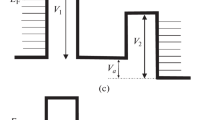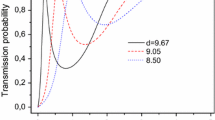Abstract
Analytical expressions for the transmission coefficient and the resonance condition in unsymmetrical rectangular double-barrier structures are derived theoretically by taking into account the mass difference between well and barrier layers. It is found that resonant tunneling with a transmission peak equal to 1 (unity resonance) and resonant tunneling with a transmission peak less than 1 (below unity resonance) may occur in the unsymmetrical double-barrier structures. Two independent conditions are required for unity-resonant transmission: One is the Phase-Difference Condition for Resonance (PDCR) and the other is the Maximum Condition for the Peak Value (MCPV). The below-unity resonant transmission occurs when only condition PDCR holds. It is believed that the two conditions are useful for calculating values of the transmission coefficient and the resonance energy for the unsymmetrical double-barrier structures. They may be useful for resonant tunneling-device fabrication. Furthermore, wave functions of an electron at resonance level are calculated and the confining phenomenon is confirmed.
Similar content being viewed by others
References
E.O. Kane: InTunneling Phenomena in Solids, ed. by E. Burstein, S. Lundqvist (Plenum, New York 1969) p. 1
M. Ya. Azbel: Phys. Rev. B28, 4107 (1983)
B. Ricco, M. Ya. Azbel: Phys. Rev. B29, 1970 (1984)
L.L. Chang, K. Ploog (eds.):Molecular Beam Epitaxy and Heterstructures (Nijhoff, Dordrecht 1985)
H. Yamamoto: Appl. Phys. A42, 245 (1987)
D.S. Chemla, A. Pinczuk (eds.): Special Issue on Semiconductor Quantum Wells and Superlattices, IEEE J. QE-22, 1609 (1986)
E.E. Mendez, K. von Klitzing (eds.).Physics and Applications of Quantum Wells and Superlattices (Plenum, New York 1987)
H. Yamamoto, Y. Kanie, K. Taniguchi: Phys. Status. Solidi B154, 195 (1989)
H. Yamamoto: Phys. Status. Solidi B140, K23 (1987)
M. Tsuchiya, H. Sakaki, J. Yoshino: Jpn. J. Appl. Phys.24, L466 (1985)
T. Futatsugi, Y. Yamaguchi, S. Muto, N. Yokoyama, A. Shibatomi: J. Appl. Phys.65, 1771 (1989)
C. Priester, G. Allan, M. Lannoo: Phys. Rev. B30, 7302 (1984)
H.C. Casey, M.B. Panish:Heterostructure Lasers, Part A (Academic, New York 1978) p. 192
J. Batey, S. L. Wright: J. Appl. Phys.59, 200 (1986)
Author information
Authors and Affiliations
Rights and permissions
About this article
Cite this article
Zhao, X.D., Yamamoto, H. & Taniguchi, K. Theoretical study of resonant-tunneling and confining phenomena with mass variation in unsymmetrical rectangular double-barrier structures. Appl. Phys. A 60, 369–376 (1995). https://doi.org/10.1007/BF01538336
Received:
Accepted:
Issue Date:
DOI: https://doi.org/10.1007/BF01538336




